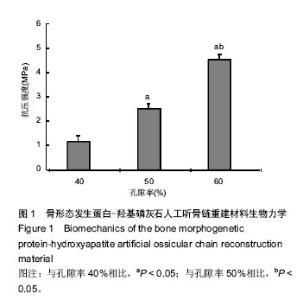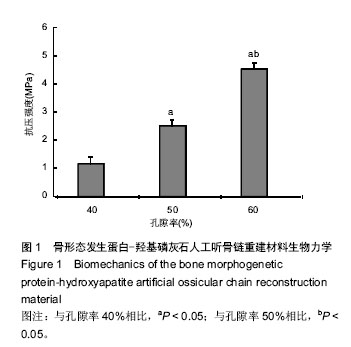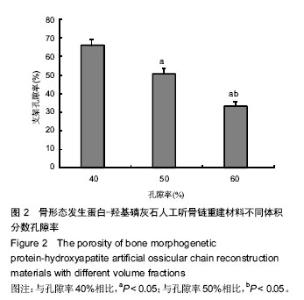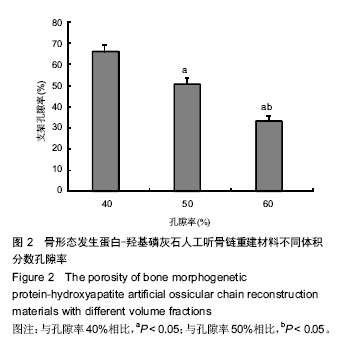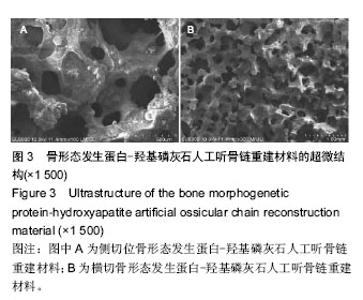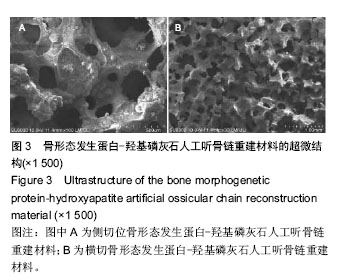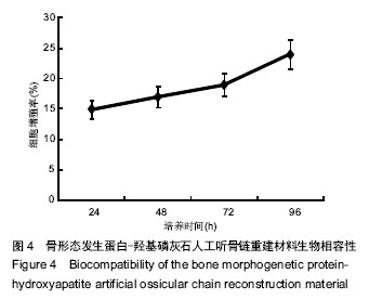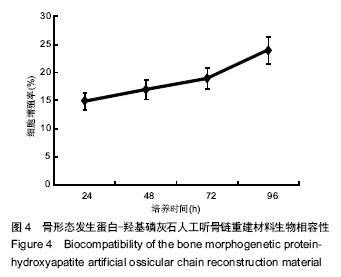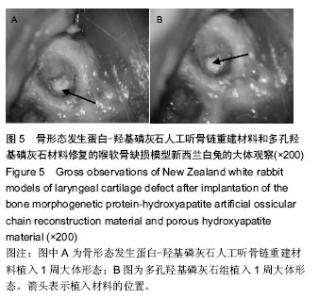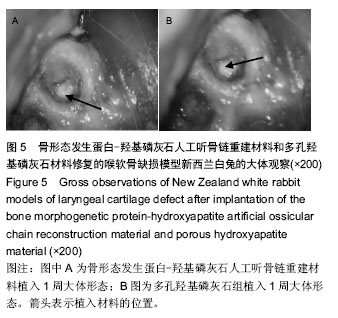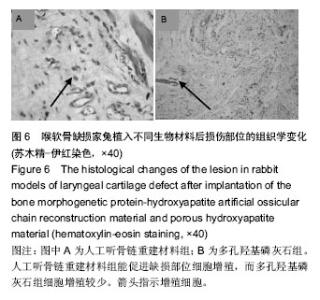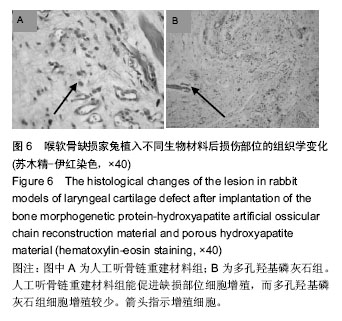Chinese Journal of Tissue Engineering Research ›› 2016, Vol. 20 ›› Issue (25): 3713-3719.doi: 10.3969/j.issn.2095-4344.2016.25.010
Previous Articles Next Articles
Artificial ossicular chain reconstruction: biocompatibility, properties and laryngecartilage defect repair
Guo Bei, Yuan Kun, Chen Wei
- Affiliated Wuhan Central Hospital, Tongji Medical College of Huazhong University of Science and Technology, Wuhan 430014, Hubei Province, China
-
Received:2016-05-07Online:2016-06-17Published:2016-06-17 -
Contact:Yuan Kun, Chief physician, Affiliated Wuhan Central Hospital, Tongji Medical College of Huazhong University of Science and Technology, Wuhan 430014, Hubei Province, China -
About author:Guo Bei, Master, Attending physician, Affiliated Wuhan Central Hospital, Tongji Medical College of Huazhong University of Science and Technology, Wuhan 430014, Hubei Province, China -
Supported by:the Natural Science Foundation of Hebei Province in 2013, No. 2013CFC082
CLC Number:
Cite this article
Guo Bei, Yuan Kun, Chen Wei. Artificial ossicular chain reconstruction: biocompatibility, properties and laryngecartilage defect repair[J]. Chinese Journal of Tissue Engineering Research, 2016, 20(25): 3713-3719.
share this article
| [1] 马林祥,崔颖,朱丽明,等.BMSCs与PLGA三维生物支架复合修复喉软骨缺损的研究[J].中国生物工程杂志, 2009,29(12):7-12. [2] Gilpin DA, Weidenbecher MS, Dennis JE. Scaffold-free tissue-engineered cartilage implants for laryngotracheal reconstruction. Laryngoscope. 2010;120(3):612-617.[3] 孙安科,胡平,李万同,等.组织工程PHBHH多孔材料喉支架的制备与细胞相容性研究[J].听力学及言语疾病杂志, 2011,19(6):558-561.[4] 孙安科,李万同,孟庆延,等.带蒂肌筋膜瓣充填与包裹构建喉支架形态组织工程软骨[J].中华耳鼻咽喉头颈外科杂志,2011,46(12):1019-1023.[5] Gardner OF, Archer CW, Alini M, et al. Chondrogenesis of mesenchymal stem cells for cartilage tissue engineering. Histol Histopathol. 2013;28(1):23-42.[6] Awad HA, Wickham MQ, Leddy HA, et al. Chondrogenic differentiation of adipose-derived adult stem cells in agarose, alginate, and gelatin scaffolds. Biomaterials. 2004;25(16):3211-3222.[7] Kim DY, Pyun J, Choi JW, et al. Tissue-engineered allograft tracheal cartilage using fibrin/hyaluronan composite gel and its in vivo implantation. Laryngoscope. 2010;120(1):30-38.[8] 刘清宇,王富友,杨柳.关节软骨组织工程支架的研究进展[J].中国修复重建外科杂志,2012,26(10):1247-1250.[9] Cool SM, Kenny B, Wu A, et al. Poly(3-hydroxybutyrate-co-3-hydroxyvalerate) composite biomaterials for bone tissue regeneration: in vitro performance assessed by osteoblast proliferation, osteoclast adhesion and resorption, and macrophage proinflammatory response. J Biomed Mater Res A. 2007;82(3):599-610.[10] 孙安科,孙靖,孙伟,等.无纺网与多孔海绵状材料作为软骨组织工程支架的适用性及体内降解性[J].中国组织工程研究,2014,18(8):1172-1178.[11] 陆源,胡敏,何玮,等.重建听骨链的鼓室成形术临床结果分析58例[J].中国社区医师:医学专业, 2011,13(24): 162-163.[12] Dunham BP, Koch RJ. Basic fibroblast growth factor and insulinlike growth factor I support the growth of human septal chondrocytes in a serum-free environment. Arch Otolaryngol Head Neck Surg. 1998;124(12):1325-1330.[13] 汪昌学,姜苏明,刘金生,等.听骨链重建术的相关解剖测量[J].汕头大学医学院学报,2007,20(3):143-145.[14] 宋升桥.采用钛质人工听骨行听骨链重建27例临床分析[J].中华耳科学杂志,2011(2):184-186.[15] 张宝林,李秀琴,王廷础.立用乳突皮质骨及自体砧骨行鼓室成型术远期疗效观察[J].中华耳科学杂志, 2004,2(1): 24-26.[16] Dupont KM, Boerckel JD, Stevens HY, et al. Synthetic scaffold coating with adeno-associated virus encoding BMP2 to promote endogenous bone repair. Cell Tissue Res. 2012;347(3):575-588.[17] Park SH, Tofighi A, Wang X, et al. Calcium phosphate combination biomaterials as human mesenchymal stem cell delivery vehicles for bone repair. J Biomed Mater Res B Appl Biomater. 2011; 97(2):235-244.[18] Che JH, Zhang ZR, Li GZ, et al. Application of tissue-engineered cartilage with BMP-7 gene to repair knee joint cartilage injury in rabbits. Knee Surg Sports Traumatol Arthrosc. 2010;18(4):496-503.[19] 王岩松,刘丹平,张元和,等.纳米羟基磷灰石/聚酰胺66骨填充材料与自体骨修复良性骨肿瘤术后骨缺损的对比研究[J].军医进修学院学报,2011,32(4):373-374.[20] 聂鹏飞,陈少文,应小洲,等.诱导膜技术治疗大段骨缺损的研究进展[J].中华创伤骨科杂志,2013,15(5):439-440.[21] Villemagne T, Bonnard C, Accadbled F, et al. Intercalary segmental reconstruction of long bones after malignant bone tumor resection using primary methyl methacrylate cement spacer interposition and secondary bone grafting: the induced membrane technique. J Pediatr Orthop. 2011;31(5):570-576.[22] Greene EL, Houghton O, Collinsworth G, et al. 5-HT(2A) receptors stimulate mitogen-activated protein kinase via H(2)O(2) generation in rat renal mesangial cells. Am J Physiol Renal Physiol. 2000;278(4): F650-658.[23] Ha H, Lee HB. Reactive oxygen species as glucose signaling molecules in mesangial cells cultured under high glucose. Kidney Int Suppl. 2000;77:S19-25. [24] Mialet-Perez J, Bianchi P, Kunduzova O, et al. New insights on receptor-dependent and monoamine oxidase-dependent effects of serotonin in the heart. J Neural Transm (Vienna). 2007;114(6):823-827. [25] Böhm P, Fritz J, Thiede S, et al. Reimplantation of extracorporeal irradiated bone segments in musculoskeletal tumor surgery: clinical experience in eight patients and review of the literature. Langenbecks Arch Surg. 2003;387(9-10):355-365. [26] Li J, Shi L, Chen GJ. Image navigation assisted joint-saving surgery for treatment of bone sarcoma around knee in skeletally immature patients. Surg Oncol. 2014;23(3):132-139. [27] Bus MP, Bramer JA, Schaap GR, et al. Hemicortical resection and inlay allograft reconstruction for primary bone tumors: a retrospective evaluation in the Netherlands and review of the literature. J Bone Joint Surg Am. 2015;97(9):738-750.[28] Andreou D, Hardes J, Gosheger G, et al. Interdisciplinary diagnostic and treatment of bone sarcomas of the extremities and trunk. Handchir Mikrochir Plast Chir. 2015;47(2):90-99.[29] 陈建良,黄冬梅.充气式硅胶橡胶赝复体修复单侧上颌骨缺损的研究[J].口腔颌面修复学杂志, 2009,10(3): 157-161.[30] 杜兵,陈巨峰,符志峰.计算机辅助设计与制作在磁性固位分体式上颌骨赝复体修复这种的应用[J].中华口腔医学研究杂志:电子版,2011,5(2):178-183.[31] 毛恩亮,戴红莲,雷军,等.热致相分离/粒子滤出法制备多孔支架的研究[J].武汉理工大学学报,2010(12):15-18.[32] Xie J, Han Z, Naito M, et al. Articular cartilage tissue engineering based on a mechano-active scaffold made of poly(L-lactide-co-epsilon-caprolactone): In vivo performance in adult rabbits. J Biomed Mater Res B Appl Biomater. 2010;94(1):80-88. [33] Swieszkowski W, Tuan BH, Kurzydlowski KJ, et al. Repair and regeneration of osteochondral defects in the articular joints. Biomol Eng. 2007;24(5):489-495. [34] Panseri S, Russo A, Cunha C, et al. Osteochondral tissue engineering approaches for articular cartilage and subchondral bone regeneration. Knee Surg Sports Traumatol Arthrosc. 2012;20(6):1182-1191. [35] Liu M, Yu X, Huang F, et al. Tissue engineering stratified scaffolds for articular cartilage and subchondral bone defects repair. Orthopedics. 2013; 36(11):868-873. [36] Pan Z, Duan P, Liu X, et al. Effect of porosities of bilayered porous scaffolds on spontaneous osteochondral repair in cartilage tissue engineering. Regen Biomater. 2015;2(1):9-19. [37] Musumeci G, Loreto C, Castorina S, et al. New perspectives in the treatment of cartilage damage. Poly(ethylene glycol) diacrylate (PEGDA) scaffold. A review. Ital J Anat Embryol. 2013;118(2):204-210. [38] Shimomura K, Moriguchi Y, Murawski CD, et al. Osteochondral tissue engineering with biphasic scaffold: current strategies and techniques. Tissue Eng Part B Rev. 2014;20(5):468-476. |
| [1] | Zhang Tongtong, Wang Zhonghua, Wen Jie, Song Yuxin, Liu Lin. Application of three-dimensional printing model in surgical resection and reconstruction of cervical tumor [J]. Chinese Journal of Tissue Engineering Research, 2021, 25(9): 1335-1339. |
| [2] | Wu Xun, Meng Juanhong, Zhang Jianyun, Wang Liang. Concentrated growth factors in the repair of a full-thickness condylar cartilage defect in a rabbit [J]. Chinese Journal of Tissue Engineering Research, 2021, 25(8): 1166-1171. |
| [3] | Li Jiacheng, Liang Xuezhen, Liu Jinbao, Xu Bo, Li Gang. Differential mRNA expression profile and competitive endogenous RNA regulatory network in osteoarthritis [J]. Chinese Journal of Tissue Engineering Research, 2021, 25(8): 1212-1217. |
| [4] | Geng Qiudong, Ge Haiya, Wang Heming, Li Nan. Role and mechanism of Guilu Erxianjiao in treatment of osteoarthritis based on network pharmacology [J]. Chinese Journal of Tissue Engineering Research, 2021, 25(8): 1229-1236. |
| [5] | Zeng Yanhua, Hao Yanlei. In vitro culture and purification of Schwann cells: a systematic review [J]. Chinese Journal of Tissue Engineering Research, 2021, 25(7): 1135-1141. |
| [6] | He Xiangzhong, Chen Haiyun, Liu Jun, Lü Yang, Pan Jianke, Yang Wenbin, He Jingwen, Huang Junhan. Platelet-rich plasma combined with microfracture versus microfracture in the treatment of knee cartilage lesions: a meta-analysis [J]. Chinese Journal of Tissue Engineering Research, 2021, 25(6): 964-969. |
| [7] | Liu Xin, Yan Feihua, Hong Kunhao. Delaying cartilage degeneration by regulating the expression of aquaporins in rats with knee osteoarthritis [J]. Chinese Journal of Tissue Engineering Research, 2021, 25(5): 668-673. |
| [8] | Deng Zhenhan, Huang Yong, Xiao Lulu, Chen Yulin, Zhu Weimin, Lu Wei, Wang Daping. Role and application of bone morphogenetic proteins in articular cartilage regeneration [J]. Chinese Journal of Tissue Engineering Research, 2021, 25(5): 798-806. |
| [9] | Xu Dongzi, Zhang Ting, Ouyang Zhaolian. The global competitive situation of cardiac tissue engineering based on patent analysis [J]. Chinese Journal of Tissue Engineering Research, 2021, 25(5): 807-812. |
| [10] | Wu Zijian, Hu Zhaoduan, Xie Youqiong, Wang Feng, Li Jia, Li Bocun, Cai Guowei, Peng Rui. Three-dimensional printing technology and bone tissue engineering research: literature metrology and visual analysis of research hotspots [J]. Chinese Journal of Tissue Engineering Research, 2021, 25(4): 564-569. |
| [11] | Chang Wenliao, Zhao Jie, Sun Xiaoliang, Wang Kun, Wu Guofeng, Zhou Jian, Li Shuxiang, Sun Han. Material selection, theoretical design and biomimetic function of artificial periosteum [J]. Chinese Journal of Tissue Engineering Research, 2021, 25(4): 600-606. |
| [12] | Liu Fei, Cui Yutao, Liu He. Advantages and problems of local antibiotic delivery system in the treatment of osteomyelitis [J]. Chinese Journal of Tissue Engineering Research, 2021, 25(4): 614-620. |
| [13] | Li Xiaozhuang, Duan Hao, Wang Weizhou, Tang Zhihong, Wang Yanghao, He Fei. Application of bone tissue engineering materials in the treatment of bone defect diseases in vivo [J]. Chinese Journal of Tissue Engineering Research, 2021, 25(4): 626-631. |
| [14] | Zhang Zhenkun, Li Zhe, Li Ya, Wang Yingying, Wang Yaping, Zhou Xinkui, Ma Shanshan, Guan Fangxia. Application of alginate based hydrogels/dressings in wound healing: sustained, dynamic and sequential release [J]. Chinese Journal of Tissue Engineering Research, 2021, 25(4): 638-643. |
| [15] | Chen Jiana, Qiu Yanling, Nie Minhai, Liu Xuqian. Tissue engineering scaffolds in repairing oral and maxillofacial soft tissue defects [J]. Chinese Journal of Tissue Engineering Research, 2021, 25(4): 644-650. |
| Viewed | ||||||
|
Full text |
|
|||||
|
Abstract |
|
|||||
